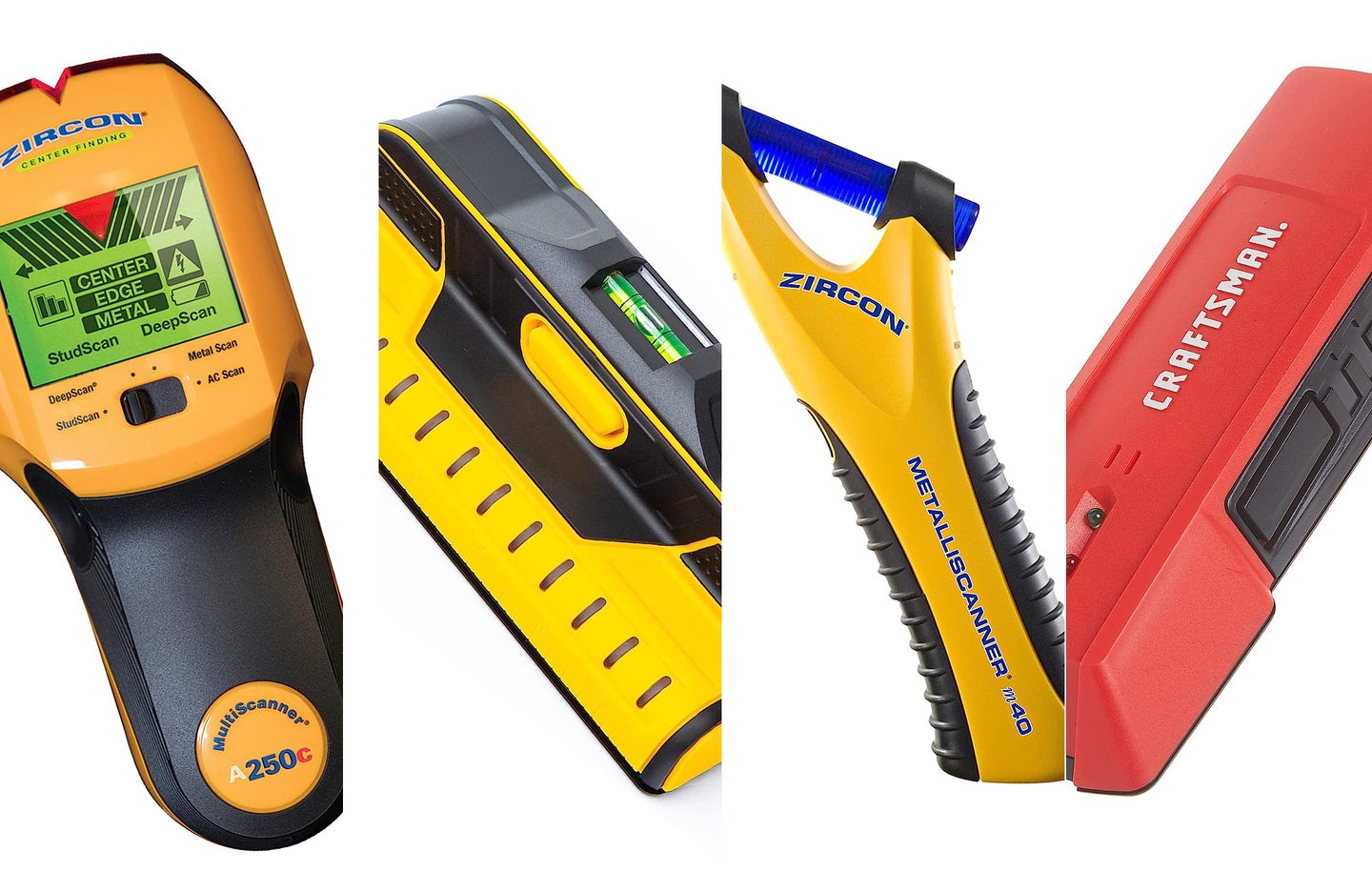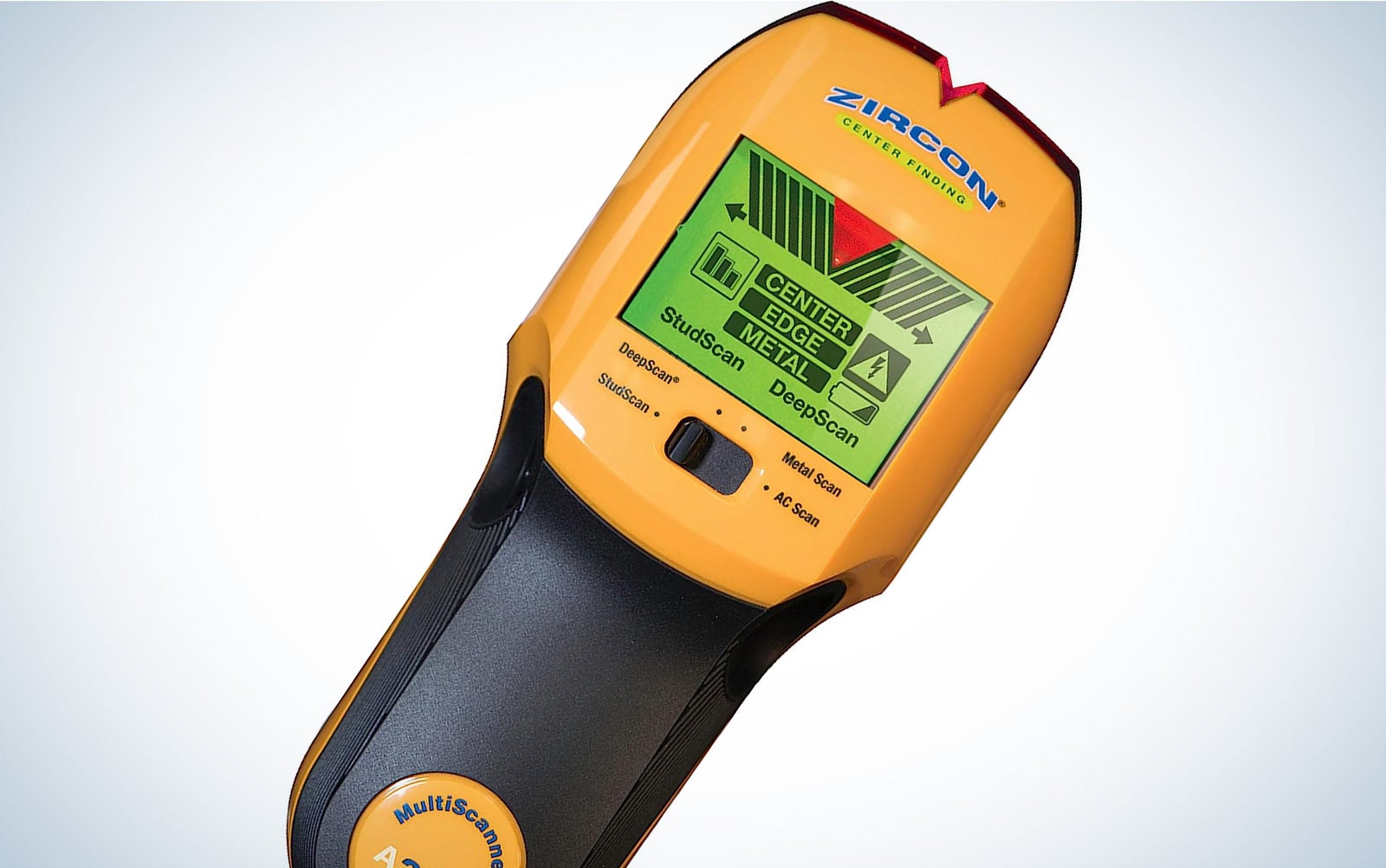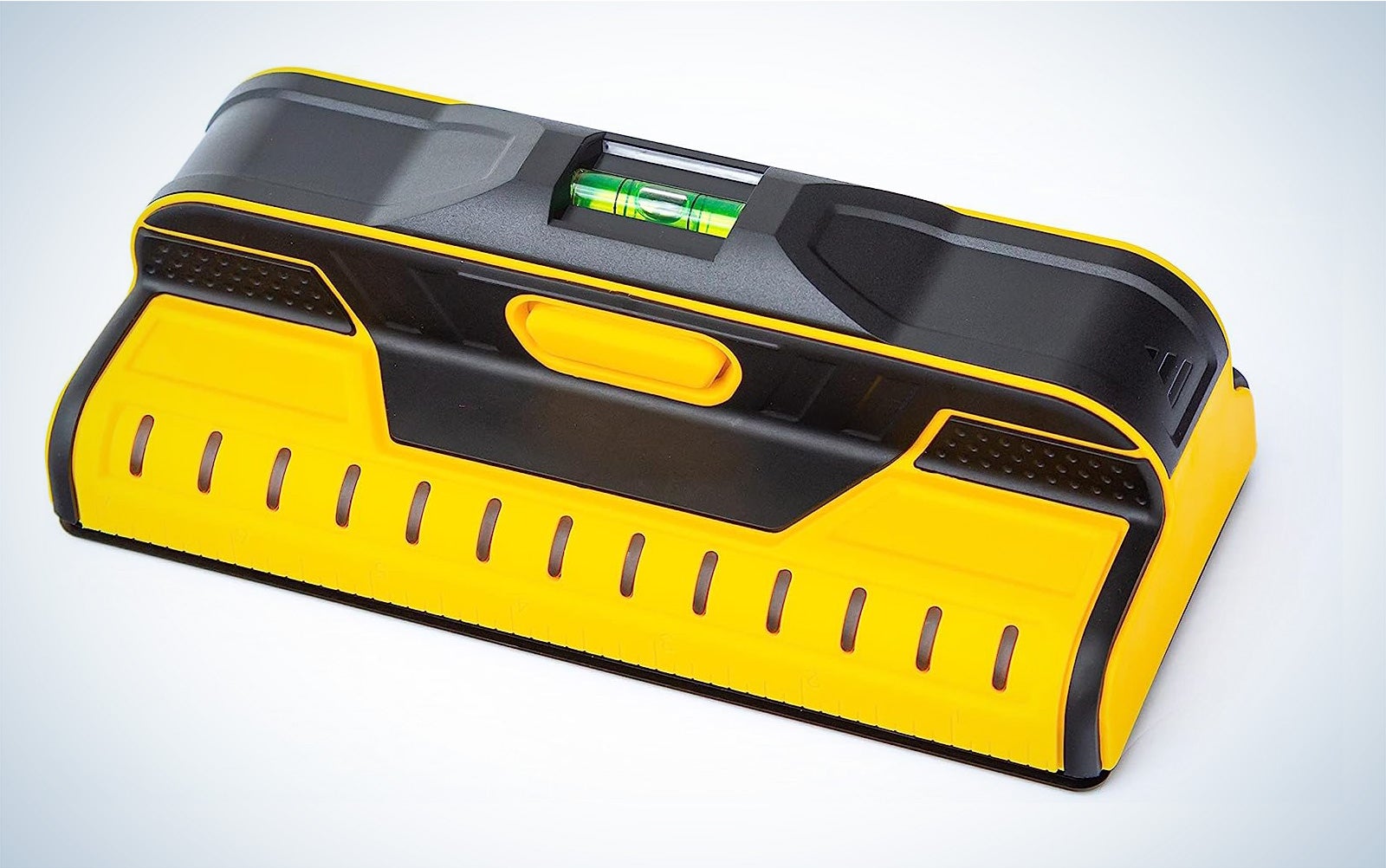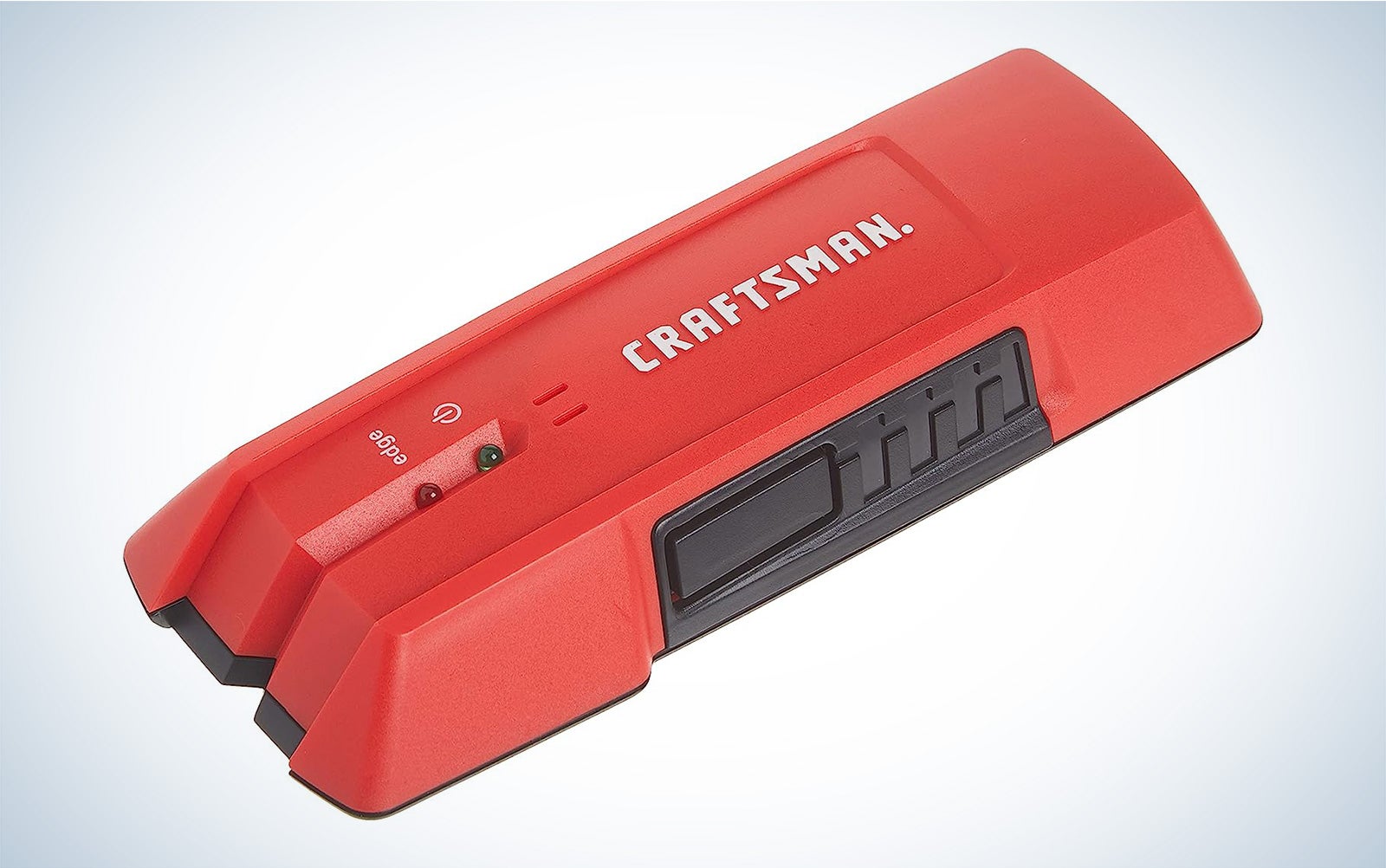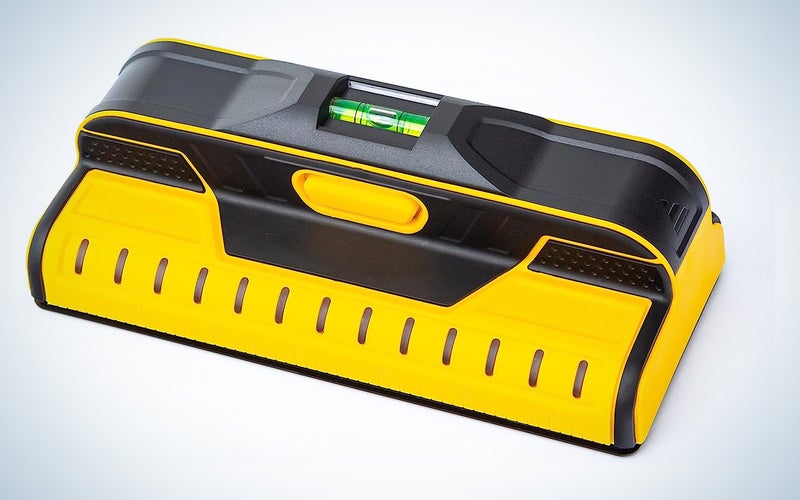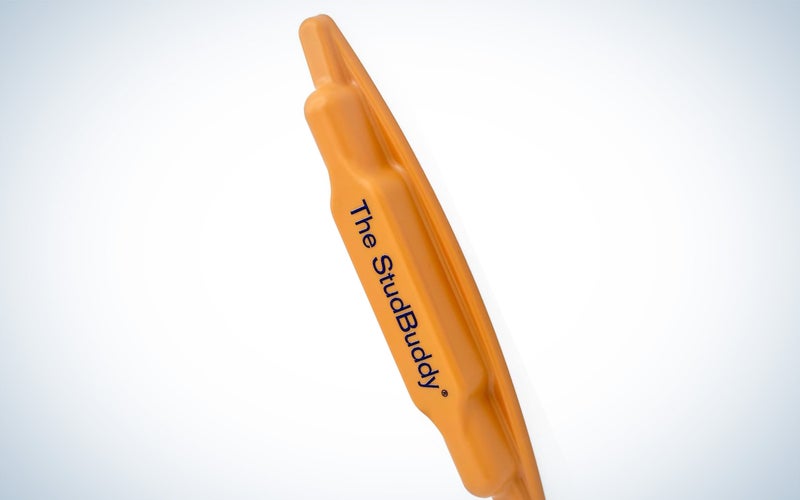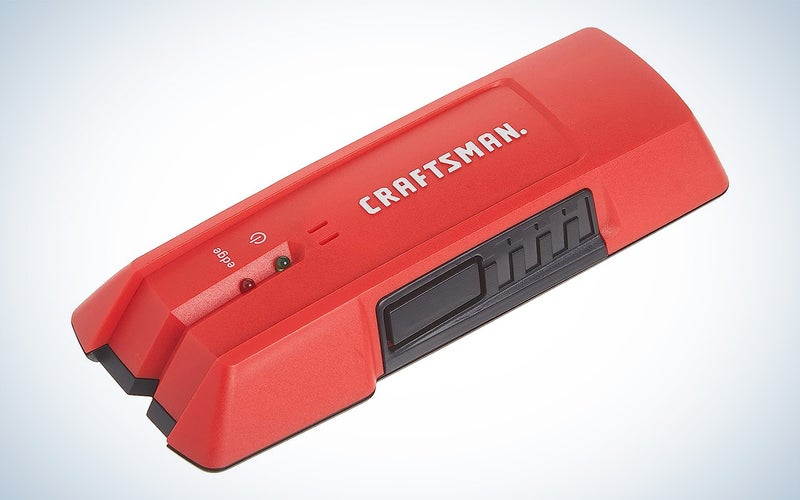We may earn revenue from the products available on this page and participate in affiliate programs. Learn more ›
A stud finder is the sort of thing that feels totally forgettable until you need one. In practice, they’re like the x-ray vision you might’ve imagined using as a kid, but instead of being made to see through walls and gleam hidden secrets, they pretty much exclusively stick to lumber, along with nails and possibly even live wires. Here, we’ll explore this wall-scanning technology for what it really is and, of course, help you pick out the best stud finders for your next project.
- Best overall: Zircon MultiScanner A250c
- Widest scan area: Franklin Sensors ProSensor T13
- Best for plaster walls: Zircon MetalliScanner m40
- Best magnetic: The StudBuddy Magnetic Stud Finder
- Best budget: CRAFTSMAN Stud Finder
How we chose the best stud finders
You’ll find that even the best stud finders are relatively simple devices. Even in 2023, you shouldn’t expect apps, smart AI, or other technologies you’re used to seeing in almost everything nowadays. You should expect batteries—the kind that need to be physically removed and replaced.
Still, even in this world of relatively tame older products, the best stud finders each find a niche to fill or have bonuses that just make sense for you. This could be because the batteries they use also go well with some of your older tools, they get the wide range you want, or they throw in something extra, like a leveler. This is definitely a category where you should avoid overthinking. As a result, we’ve focused on quality products—with a large (and happy) customer base—that fill their niches well and come out at a reasonable price.
The best stud finders: Reviews & Recommendations
The best stud finders for you will typically fill one or more of a few distinct types. Widely used—and customer-approved—products tested repeatedly in practical environments with high margins of success are obvious inclusions. Premium “kitchen sink” varieties that throw in a lot of extras (such as levelers), have tons of sensors over a wide range, and use superior UIs can be attractive options as well. Finally, niche picks and those covering a wide variety of battery requirement options were considered throughout to give everyone a high chance of finding a viable product that meets their standards. Finding the right value for the output helps tremendously as well. Taking all those factors into consideration, these are the stud finders we suggest you put in your tool box.
Best overall: Zircon MultiScanner A250c
Zircon
Why it made the cut: When your mind thinks “modern stud finder,” this is probably what you’re picturing—and it works well, too.
Specs
- Sensors: 1 Stud/metal/wire, Center
- Battery requirements: 1 x 9-volt
- Interface: Graphical UI
Pros
- Incorporates tech to correct user errors
- “All-in-one” tool
- Notch for marking at top
Cons
- More expensive than most
- No battery included
When you think of a single-sensor stud finder, you’re probably thinking of something in a form factor very similar to that of the Zircon Multiscanner A250c. It’s got a handle and head not too unlike what you’re used to seeing, as well as that orange-ish yellow that just screams stud finder or similar tool.
The Zircon Multiscanner A250c stands out from the crowd of “typical stud finders,” however, for its multiple scanning modes and special features. In other words, it is way more of an all-rounder than you’re expecting.
It has multiple scanning modes, including the ability to look for studs through varying depths of drywall, and a metal mode capable of searching through more dense materials.
The ACT (Auto Correcting Technology) eliminates errors from common user “problems.” For example, if you start directly over a stud that can cause issues with other stud finders, you’ll be impressed with the Zircon Multiscanner A250c. And it makes sense because why should we be punished for starting out in the right spot?
Ultimately, the Zircon Multiscanner A250c is going to be the best stud finder for just about any situation, but it is more expensive than any of the others on this list. It is also a single-sensor finder, which means it lacks the versatility others offer. So, if you’re looking for something a bit more singular in purpose or with more sensors, you can find that for cheaper elsewhere on the list. However, if you want the best and are willing to pay (just a bit) extra for it, go ahead and grab the Zircon Multiscanner A250c.
Widest scan area: Franklin Sensors ProSensor T13
Franklin Sensors
Why it made the cut: This offering from Franklin is one of the widest stud finders available.
Specs
- Sensors: 13 edge/center
- Battery requirements: 2 x AA (disposable only)
- Interface: Multi-LED lights
Pros
- Wide 9.7-inch span
- 1.7-inch scan depth
- Bonus features include bubble leveler, ruler, and pencil caddy
- Rare AA battery user
Cons
- Doesn’t work with rechargeable AA batteries
To get the job done quickly, you need something with some width. That’s the thinking, at least, when it comes to the Franklin Sensor ProSensor T13, which is over 9.7 inches wide and sports a 13-sensor array.
The Franklin Sensor ProSensor T13 uses one-button sensing, with the machine picking the best scanning mode automatically. Just move it over the wall, and the sensors’ associated LED lights will shine, giving you a full mental picture of the target stud. It also has a built-in ruler, bubble leveler, and a spot for your pencil so you have nearly everything you need when it is time to get started working.
It is nice to see a stud finder that uses AA batteries, regarded as the most popular battery style. However, there is an unusual quirk with the AA batteries that you can use with the Franklin Sensor ProSensor T13. They must be of the disposable type; rechargeables may still work, but they will likely die very quickly.
Best for plaster walls: Zircon MetalliScanner m40
Zircon
Why it made the cut: It’s like a metal detector for your walls, even the dense ones.
Specs
- Sensors: 1 metal detector
- Battery requirements: 1 x 9-volt
- Interface: LED lights
Pros
- Locates metals through plaster and plath
- Works with cement, concrete, stucco, and drywall as well
- Ignores density, looks for metal
Cons
- Detects metal, not wood.
The Zircon MetalliScanner m40 handles an increasingly rare situation—dense plaster walls—better than its competition. Plaster walls, which fell out of usage after the 1940s, present a unique situation for other stud finder sensors as these walls are intensely dense all the way through. That makes studs hard to locate with typical methods.
The Zircon MetalliScanner m40 detects the metal nails or screws in the studs themselves to help you locate them without relying on density measurements.
It also has this metal sensing through other materials as well, making it the best for ceramic tile as well. However, this still stands as the best stud finder for old homes, not newer ones, due to the way it works. Of course, if you have an unusual material your home is made from, it is always worth a try.
Best magnetic: The StudBuddy Magnetic Stud Finder
StudBuddy
Why it made the cut: This classic magnetic stud finder has an easy grip and hangs to the wall.
Specs
- Sensors: N/A
- Battery requirements: N/A
- Interface: N/A
Pros
- Comfortable grip
- No batteries needed
- Cheap and always functional
Cons
- In some ways, just a magnet
Despite its simplicity, the StudBuddy is one of the higher-rated stud finders you’ll find in stores. In so many words, it is “just” a (neodymium) magnet. In more flattering terms, it uses “old school tech” and sensibilities of the highest order. The StudBuddy uses magnetism to locate nails already in studs in your wall. It will even stick to the wall in the spot near a detected nail, showing you the line where you should pull out one of your favorite cordless drills and get busy. If one nail went in that vertical space, the thinking goes, so should yours.
It goes without saying that the StudBuddy is not the perfect machine. There are reasons we’ve updated the technology from magnets to sensors. However, it remains one of the best stud finders for its charms: the elegantly designed handle, its ability to stick to the wall, and its no-battery forever-ready design. It can go anywhere and might’ve earned itself a place in your bag for that reason alone.
Please note that there is also a StudBuddy Plus, which includes rubber grips, two bubble levelers, and inch and centimeter rulers along its small perimeter. At nearly twice the price of the original StudBuddy (which is nearly always ~25% off), it is harder to recommend, though. So, unless you’re trying to build the ultimate minimalist kit of battery-free tools, the ‘Plus’ is a pass while the original StudBuddy stays in.
Best budget: Craftsman Stud Finder
Craftsman
Why it made the cut: This is a relatively straightforward stud finder without the frills (or the price) of premium-grade finders.
Specs
- Sensors: 1 edge detection
- Battery Requirements: 1 x 9-volt
- Interface: LED light
Pros
- Works simply
- Great value for the money
- Once you get the hang of it, easy to execute
Cons
- Low documentation
- No battery included
The Craftsman Stud Finder is a low-cost but often misunderstood stud finder of the edge detection variety. There are a couple of tips and tricks for it, which we’ll discuss shortly, but once you get the hang of it, you’ll probably be happy with it. If you don’t need something intensely feature-rich, this could be the best stud finder for you.
One issue with the Craftsman Stud Finder is that it doesn’t necessarily present itself in the most straightforward manner. There isn’t a ton of hand-holding. For instance, the most upsetting find for most people is that they get the Craftsman only to find out they needed to pick up the not included, but very necessary, 9-volt battery to operate it.
And operating it, too, can be an issue due to low levels of instruction. However, once you know its secrets, you can use it easily. The Craftsman Stud Finder detects edges only and doesn’t work well when started on a stud. Move the Craftsman Stud Finder from the left of the stud you want to the right. It’ll light up when the left side of the stud is found. Then, do the same from the right side, moving to the left.
What to consider before buying the best stud finders
Choosing a stud finder should be a relatively straightforward affair, but there are still a few things that you need to take into consideration before choosing one. The number of sensors and width of your stud finders’ effective area will affect the convenience of use, as will the stud finder’s interface. Lastly, because even the best stud finders are relatively simple, they can come filled with extra features that are worth exploring.
Number of sensors
One of the quickest ways to add speed to your stud finding is to increase the number of sensors. One common form factor that works this way is the “array of sensors” style. It’s like having extra stud finders tied together, all working at once. Additionally, as each one scans at the same time, these multi-sensor stud finders are the best stud finders for real-time visualization of the stud. As they usually spread wider than the stud, you can “see” the full stud all at one time.
Style of sensor
Another factor to consider here is the styles of sensors on the stud finder. Edge finders will help you find the edge of the stud, while center finders will help you find the stud itself.
Typically, you’ll just see sensors capable of detecting changes in density just beyond the width of a typical piece of drywall. It won’t necessarily matter what that change in density is. However, some sensors can detect more. This includes stud finders that can distinguish iron pipes, detect through ceramic tile and other materials, and even find livewires.
Remember that stud finders can be wrong, including with livewire detection. Don’t trust your life with one. If there is even the slightest chance of a livewire being in the area you’re driving nails into, take extreme caution. Instead, use these only to help you find the best place to knock into and ensure the power is out before proceeding. When in doubt, contact a real electrician.
Interface
As has already been stated, stud finders are not incredibly complex. As a result, there are only two types of interfaces you’ll see, neither of which are incredibly modern in appearance.
The first style is a simple detection and light system. When a sensor gets a reading, a light brightens. This style is incredibly simple and quite common for stud finders with an array of sensors. This contrasts highly with the second common style, which is a simple LED graphical UI. Think more TI-80 calculator (or worse) than any UI you’ve seen in recent years, but still serviceable enough to give you any required information.
In actuality, neither system is better than the other, and the best stud finders will include those of both interface types. Sometimes, even for a simple single-sensor stud finder, a simple light is best as there is such a thing as overcomplicating the simple.
Additional features
To stand out, manufacturers will add features of varying degrees of usefulness. These bonus features can vary from being neigh-on essential (at least, for you) to being expensive price boosters. If you already have one of the best home tool kits, you will likely find yourself not needing too many extras on your stud finder.
The most common appendage to a stud finder, a leveler—a tool that finds a gravitationally level surface—is a logical choice. Much like putting a bottle opener on a corkscrew, it makes sense to plop a leveler on a stud finder.
This is especially true when it is the serviceable but simple water-and-bubble type leveler. They’re cheap and an obvious throw-in. When offered a stud finder with a more advanced laser leveler, be wary of falling for two mediocre products as one when you just wanted one good product. If you choose to go the route of getting a stud finder with a laser leveler, ensure that both are quality or get them separately.
Other stud finder bonuses include tape measures, lights, pencil caddies, and other easily attachable gadgets.
FAQs
Q: How much does a stud finder cost?
A stud finder costs anywhere from $10 to over $50, depending on functionality. A simple magnetic stud finder should only be about $10, while a successful multi-tool with multiple scan modes can easily go over $50. Expect to pay about $30 for a decent stud finder.
Q: Can you trust a stud finder?
You can trust a stud finder for the most part, but you shouldn’t do so blindly. As basic stud finders detect changes in frequency—and the most typical kinds are really only rated to do so through drywall—anything behind the wall can trigger one. More advanced stud finders can detect different substances and even live wires. Still, this doesn’t mean a stud finder will be 100% accurate. Few things are! Whenever dealing with electricity, ensure that all power in the area is out before proceeding.
Q: What kind of battery does a stud finder take?
A stud finder typically takes a 9-volt battery, AAA, or even a AA battery. Typically, stud finders (even the best stud finders) do not have the built-in batteries we’re becoming increasingly used to in our other machines (but you can still buy exchangeable rechargable ones).
Final thoughts on the best stud finders
- Best overall: Zircon MultiScanner A250c
- Widest scan area: Franklin Sensors ProSensor T13
- Best for plaster walls: Zircon MetalliScanner m40
- Best magnetic: The StudBuddy Magnetic Stud Finder
- Best budget: Craftsman Stud Finder
Getting a good stud finder should not be difficult. Generally, the best stud finders come in very few distinct form factors. This means that picking one that suits your needs, has quality hardware, and a consistent customer experience, should be simple if your research is done correctly. As a result, any of the above stud finders could be the best stud finder for you.
Why trust us
Popular Science started writing about technology more than 150 years ago. There was no such thing as “gadget writing” when we published our first issue in 1872, but if there was, our mission to demystify the world of innovation for everyday readers means we would have been all over it. Here in the present, PopSci is fully committed to helping readers navigate the increasingly intimidating array of devices on the market right now.
Our writers and editors have combined decades of experience covering and reviewing consumer electronics. We each have our own obsessive specialties—from high-end audio to video games to cameras and beyond—but when we’re reviewing devices outside of our immediate wheelhouses, we do our best to seek out trustworthy voices and opinions to help guide people to the very best recommendations. We know we don’t know everything, but we’re excited to live through the analysis paralysis that internet shopping can spur so readers don’t have to.
